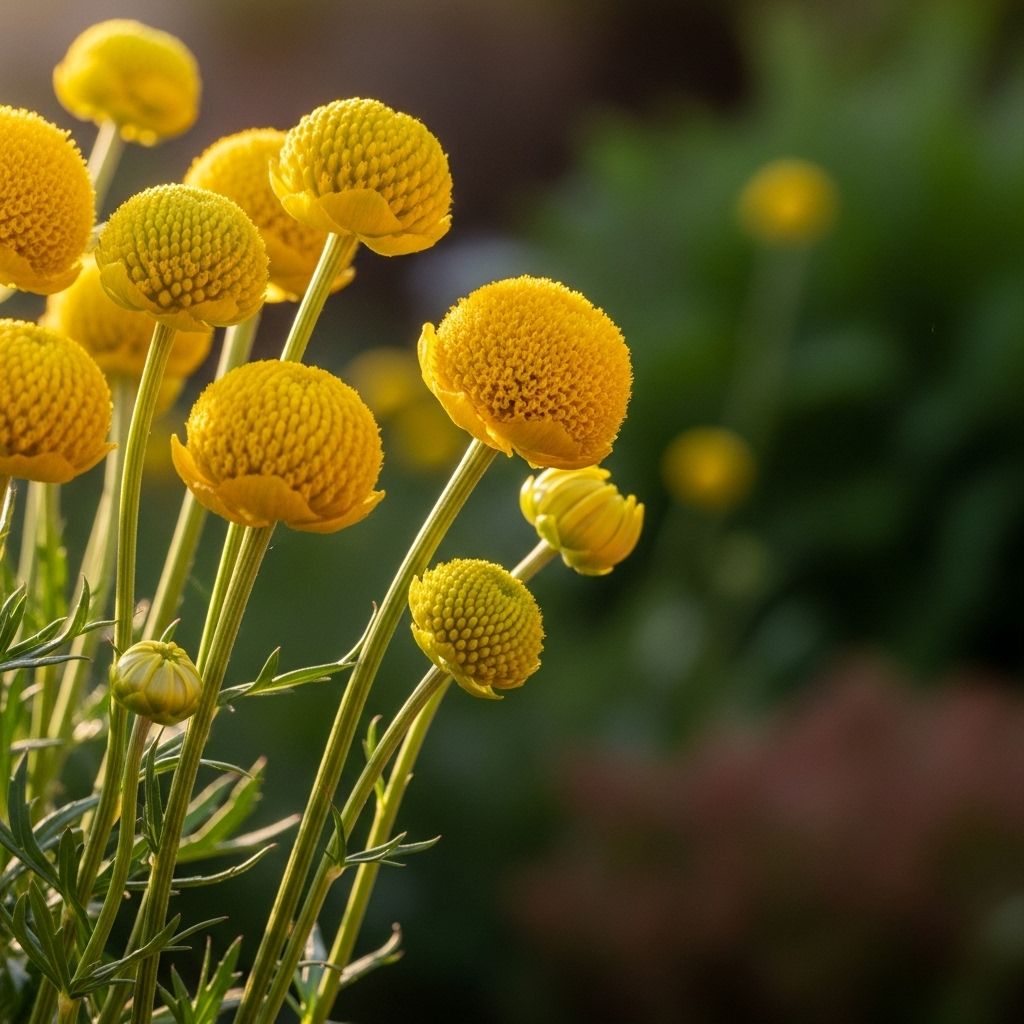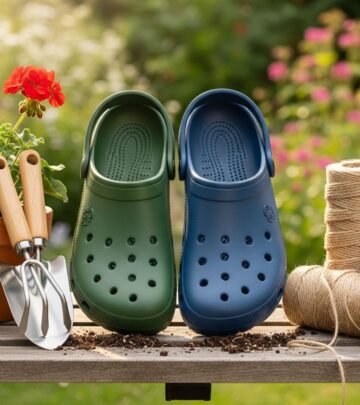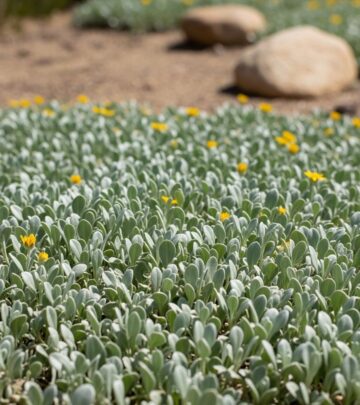Billy Buttons Plant Care: A Complete Guide For Gardeners
Discover how to cultivate, care for, and creatively use these charming yellow globe flowers in your garden landscape

Image: HearthJunction Design Team
Introduction to Billy Buttons
Billy Buttons, botanically known as Craspedia, are distinctive flowering plants that have gained popularity among gardeners and floral enthusiasts alike. These unique perennials feature bright yellow globe-shaped flower heads that stand proudly atop long, leafless stems, creating a dramatic visual impact in any garden setting. Also known as Sun Balls or Woollyheads, these charming plants originate from Australia and New Zealand, where they thrive in the wild across grasslands and meadows.
What makes Billy Buttons particularly appealing to gardeners is their versatility and low-maintenance nature. These sunny globes bring a cheerful pop of color to garden beds and make excellent additions to flower arrangements, both fresh and dried. With their striking appearance and hardy constitution, Billy Buttons have become a favorite choice for gardeners looking to add unique textural elements to their landscape design.
Characteristics and Varieties
Craspedia plants are members of the Asteraceae family, related to daisies and sunflowers. Their most distinctive feature is the perfectly round, bright yellow flower head, which can reach up to two inches in diameter. These globular blooms consist of numerous tiny individual flowers compacted together to form what appears to be a single spherical flower. The leafless flower stalks can grow between 1 to 3 feet tall, creating a dramatic visual effect when planted in groups.
While Craspedia globosa is the most commonly cultivated species, there are several varieties worth considering for your garden:
- Craspedia globosa – The classic Billy Button with bright yellow globe flowers
- Craspedia variabilis – Features slightly smaller flower heads but with the same vibrant yellow color
- Craspedia aurantia – Offers a more orange-yellow tone to the globular blooms
- Craspedia canens – Displays silvery-gray foliage with the traditional yellow flower heads
The foliage of Billy Buttons typically forms a basal rosette of lance-shaped, silver-green leaves that are often fuzzy or woolly in texture. This attractive foliage provides an excellent contrast to the bright yellow blooms and adds visual interest even when the plants aren’t flowering.
Growing Conditions and Requirements
Sunlight Requirements
Billy Buttons thrive in full sun conditions and require at least six hours of direct sunlight daily to perform their best. Adequate sunlight is crucial not only for flower production but also for maintaining strong, upright stems. When grown in insufficient light, the stems tend to lean and flop over, diminishing the plant’s architectural appeal. In particularly hot climates, these plants can tolerate partial afternoon shade, but flowering may be reduced in significantly shaded locations.
Soil Preferences
One of the most appealing aspects of Billy Buttons is their adaptability to various soil types. These resilient plants can grow in most soil conditions provided there is good drainage. Billy Buttons absolutely cannot tolerate waterlogged conditions, as this quickly leads to root rot and plant death. For optimal growth:
- Choose or create well-drained soil
- If your garden has heavy clay soil, amend it with approximately 30% sand to improve drainage
- For sandy soils, incorporate high-quality organic compost to improve nutrient content while maintaining drainage
- Aim for a soil pH that is neutral to slightly acidic
When planting in containers, ensure the pot has adequate drainage holes and include a layer of gravel or pot shards at the bottom to prevent water from collecting around the roots.
Climate Considerations
Native to Australia and New Zealand, Billy Buttons are naturally adapted to withstand drought conditions and prefer warm climates. They are generally hardy in USDA zones 8-11, though in colder regions they can be grown as annuals or overwintered indoors. These plants appreciate warm temperatures during their growing season and can tolerate brief periods of drought once established.
Planting Billy Buttons
Starting from Seeds
Growing Billy Buttons from seed is relatively straightforward but requires patience. Here’s how to successfully start your Craspedia plants from seed:
- Prepare a weed-free seed bed with loose, well-drained soil
- Sow seeds on the surface of the growing medium, as Billy Button seeds need light for germination
- Lightly cover with a thin layer of peat moss or fine sand
- Keep the soil consistently moist until germination occurs
- Maintain a warm environment between 65-75°F (18-24°C)
- Expect germination within 14-21 days
For a head start, seeds can be started indoors 6-8 weeks before the last expected frost. Once seedlings have developed at least two sets of true leaves, they’re ready for transplanting.
Transplanting Seedlings
Whether you’ve grown your own seedlings or purchased young plants, proper transplanting is essential for establishing healthy Billy Buttons:
- Wait until all danger of frost has passed, typically in May
- Select a location with full sun and well-drained soil
- Dig holes slightly larger than the root ball of each plant
- Space plants approximately 10-12 inches apart in all directions
- Plant at the same depth as they were in their containers
- Water thoroughly after planting to help establish root contact with the soil
Billy Buttons look particularly effective when planted in small groups of three to five specimens, creating a more natural and visually striking display in the garden.
Care and Maintenance
Watering Schedule
One of the most appealing aspects of Billy Buttons for busy gardeners is their drought tolerance. Once established, these plants require minimal watering and actually prefer to dry out between waterings. Overwatering is far more dangerous to Billy Buttons than underwatering, so follow these guidelines:
- Water newly planted specimens regularly until established
- For established plants, water only during extended periods of drought
- Always water at the soil level rather than overhead to prevent fungal issues
- Allow the top inch of soil to dry completely before considering additional water
During particularly hot, dry periods, a deep watering once every two weeks should be sufficient for established plants.
Fertilization Needs
Billy Buttons are not heavy feeders and typically don’t require extensive fertilization. In fact, overly rich soil can lead to leggy growth and reduced flowering. For optimal results:
- Apply a slow-release, balanced fertilizer once at the beginning of the growing season
- Alternatively, incorporate well-aged compost or manure around plants in spring
- Avoid high-nitrogen fertilizers which promote leafy growth at the expense of flowers
In particularly poor soils, a second light application of fertilizer midway through the growing season can help maintain plant vigor and flowering performance.
Pest and Disease Management
Billy Buttons are generally resistant to most pests and diseases, making them relatively worry-free additions to the garden. However, they can occasionally face challenges from:
- Spider mites – Particularly during hot, dry conditions
- Snails and slugs – May damage young foliage
- Root rot – Caused by overwatering or poor drainage
The best defense against these issues is prevention through proper growing conditions. Ensure good air circulation around plants, avoid overhead watering, and maintain well-drained soil to minimize potential problems. If spider mites appear, a strong spray of water on the undersides of leaves can dislodge them, while organic slug deterrents can protect against mollusk damage.
Harvesting and Using Billy Buttons
Cutting for Fresh Arrangements
Billy Buttons make exceptional cut flowers, with their sturdy stems and long-lasting blooms adding distinctive textural elements to arrangements. For the best results when harvesting:
- Cut stems in the morning when plants are fully hydrated
- Select flowers that are fully formed but still vibrant
- Cut stems longer than needed to allow for adjustment in arrangements
- Place immediately in clean water
- Remove any foliage that would sit below the waterline
Fresh Billy Button blooms can last up to two weeks in a vase with proper care, making them excellent value as cut flowers.
Drying Techniques
Perhaps even more popular than fresh Billy Buttons are dried specimens, which retain their distinctive shape and much of their color for months or even years. To dry Billy Buttons successfully:
- Harvest stems when flowers are fully developed
- Bundle 5-7 stems together with twine or a rubber band
- Hang upside down in a dark, dry, well-ventilated area
- Allow to dry completely for 2-3 weeks
- Once dried, spray with hairspray to help preserve color (optional)
Dried Billy Buttons can be used in wreaths, permanent arrangements, or crafting projects. For added creativity, dried blooms can be spray-painted in different colors to coordinate with specific decor schemes or seasonal displays.
Frequently Asked Questions
Q: Can Billy Buttons be grown in containers?
A: Yes, Billy Buttons adapt well to container growing provided the pot has excellent drainage. Use a high-quality potting mix amended with additional sand or perlite, and ensure the container is at least 12 inches deep to accommodate their root system.
Q: How long do Billy Buttons bloom?
A: With proper care, Billy Buttons typically bloom from late spring through summer. Removing spent flower heads can sometimes encourage additional blooming, extending the display period into early fall.
Q: Are Billy Buttons deer resistant?
A: Yes, Billy Buttons are generally considered deer resistant due to their slightly woolly texture and the fact that they’re not particularly palatable to browsing wildlife. This makes them excellent choices for gardens in areas with high deer populations.
Q: Do Billy Buttons attract pollinators?
A: Billy Buttons are attractive to various pollinators, particularly bees and butterflies. Incorporating them into your garden can help support local pollinator populations while adding visual interest to your landscape.
Q: Can Billy Buttons survive winter in cold climates?
A: Billy Buttons are perennial in USDA zones 8-11. In colder regions, they can be grown as annuals or brought indoors for overwintering. In marginally cold areas, a thick layer of mulch around the plant’s base may help it survive milder winters.
Conclusion
With their distinctive appearance, low maintenance requirements, and versatility in both the garden and floral arrangements, Billy Buttons have rightfully earned their place as beloved garden specimens. Whether you’re looking to add unique textural elements to your landscape, create eye-catching flower arrangements, or explore the world of dried florals, these cheerful yellow globes deliver exceptional value and visual impact.
By providing the basic needs of full sun, well-drained soil, and minimal watering, you can enjoy the quirky charm of these Australian natives in your own garden. Their drought tolerance makes them particularly valuable in water-conscious landscapes, while their resistance to pests and diseases ensures they’ll remain relatively trouble-free throughout the growing season.
Whether showcased in contemporary garden designs, cottage gardens, or naturalistic plantings, Billy Buttons offer a distinctive presence that’s sure to spark conversation and bring a smile to any garden visitor. With proper care, these resilient plants will reward you with their cheerful blooms year after year, proving that sometimes the most unusual plants make the most memorable garden additions.
References
- https://www.gardenista.com/posts/gardening-101-billy-buttons/
- https://www.gardenista.com/products/craspedia-flower-billy-buttons-sun-ball/
- https://www.pinterest.com/pin/billy-buttons-a-guide-to-growing-and-enjoying-craspedia-globosa–325103666864276495/
- https://grow.edenbrothers.com/planting-guides/billy-button-seeds/
- https://plantura.garden/uk/flowers-perennials/craspedia/craspedia-overview
Read full bio of Anjali Sayee












